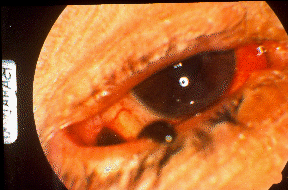
Holly Tucker of Vanderbilt University writesa nice piece on our fine friends in the most recent New Scientist magazine. Check it out!



 "The spot where Valley river joins Hiwassee, at Murphy, in North Carolina, is known among the Cherokees as Tlanusi'yï, 'The Leech place,' and this is the story they tell of it:
"The spot where Valley river joins Hiwassee, at Murphy, in North Carolina, is known among the Cherokees as Tlanusi'yï, 'The Leech place,' and this is the story they tell of it: I have often shown the image at right in public presentations about leeches. If you look closely you can see a Dinobdella ferox peeking out from behind someone's
I have often shown the image at right in public presentations about leeches. If you look closely you can see a Dinobdella ferox peeking out from behind someone's  The sensational story of Princess Caraboo regards a young lady arriving in Almondsbury, England (just North of Bristol) in 1817, speaking a strange tongue and sporting various tattoos. When it was determined that she was a Princess of Javasu, kidnapped by pirates from her Indian Ocean home, she was taken in by the local dignitaries and feted for some 2 months as visiting royalty. Her scam was exposed in short order. There is no Island of Javasu. She was, in truth, one Mary Baker from Witheridge near Exeter, who, unable to find continued employment as a servant, had hit upon this rather novel method for achieving food and shelter. After being shipped off to the US by her duped, and now chastened, benefactors, the Worralls, Mary eventually returned to Bristol and by 1839 was more gainfully and respectably employed... selling leeches, of course.
The sensational story of Princess Caraboo regards a young lady arriving in Almondsbury, England (just North of Bristol) in 1817, speaking a strange tongue and sporting various tattoos. When it was determined that she was a Princess of Javasu, kidnapped by pirates from her Indian Ocean home, she was taken in by the local dignitaries and feted for some 2 months as visiting royalty. Her scam was exposed in short order. There is no Island of Javasu. She was, in truth, one Mary Baker from Witheridge near Exeter, who, unable to find continued employment as a servant, had hit upon this rather novel method for achieving food and shelter. After being shipped off to the US by her duped, and now chastened, benefactors, the Worralls, Mary eventually returned to Bristol and by 1839 was more gainfully and respectably employed... selling leeches, of course.
 The notion that leeches can predict inclement weather achieved its zenith with the creation of the Tempest Prognosticator (at left) by Yorkshireman inventor George Merryweather, and which he put on display at the first World's Fair (the Great Exhibition at London's Crystal Palace in 1851). The idea seems to trace back to the (occasionally insane) William Cowper (1731-1800) who wrote
The notion that leeches can predict inclement weather achieved its zenith with the creation of the Tempest Prognosticator (at left) by Yorkshireman inventor George Merryweather, and which he put on display at the first World's Fair (the Great Exhibition at London's Crystal Palace in 1851). The idea seems to trace back to the (occasionally insane) William Cowper (1731-1800) who wrote  The February 2009 issue of Popular Science magazine has listed a suite of 2009's worst jobs in science. Among them is Leech Researcher. Amusing and well-written article by Jason Daley. I must say though... I really think I've got the best job in the world (maybe next to Carl Zimmer).
The February 2009 issue of Popular Science magazine has listed a suite of 2009's worst jobs in science. Among them is Leech Researcher. Amusing and well-written article by Jason Daley. I must say though... I really think I've got the best job in the world (maybe next to Carl Zimmer).
